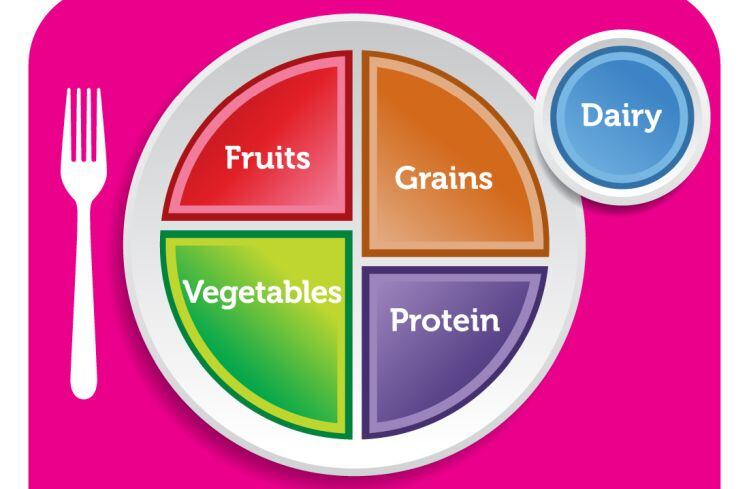The 835-page scientific report of the Dietary Guidelines Advisory Committee will inform USDA and the Department of Health and Human Services (HHS) as they develop the 2020-2025 Dietary Guidelines for Americans, and includes first-ever dietary recommendations for infants from birth through 24 months.
USDA and HHS are accepting written public comments on the report through August 13, while the public will also have an opportunity to provide oral comments at a public meeting on August 11 ahead of the publication of the final guidelines by the end of December 2020.
Options are laid out for three healthy food patterns: Healthy US Style Pattern, the Healthy Vegetarian Pattern, and the Healthy Mediterranean-Style Pattern. However, as in previous years, the advice broadly is to:
- Eat more: “Vegetables, fruits, legumes, whole grains, nuts and seeds, with some vegetable oils, low-fat dairy, lean meat and poultry, and fatty fish.”
- Eat less: “Red and processed meats, sugar-sweetened foods and drinks, and refined grains.”
You can read the report in full HERE, but here are some highlights:
Alcohol and added sugars
Men should consume no more than one alcoholic drink a day: “There is evidence to tighten them [recommendations] for men such that recommended limits for both men and women who drink would be one drink per day on days when alcohol is consumed... emerging evidence suggests the magnitude of risk associated with low volume alcohol consumption may have been underestimated.”
Adults should halve consumption of added sugars: Less than 6% of energy should come from added sugars (vs less than 10% in the 2015-20 guidelines), says the committee, which noted that average consumption is currently 13% of daily energy intakes, or nearly 17 tsp equivalents per day.
“Although intake of added sugars remains high, data reviewed by the 2020 committee suggest the consumption of added sugars decreased slightly over the last decade, suggesting a reduction is feasible,” the report noted.
Infants, kids and teens...
Kids under two years should avoid all sugar-sweetened beverages: “The combinations of foods needed to achieve recommended intakes of key nutrients for ages six to 24 months leave virtually no remaining dietary energy for added sugars,” said the committee, noting that the intake of added sugars "precipitously increases in ages 12 to 24 months, with an average of about 6.2 tsp eq consumed on a given day.”
It added: “Avoiding consumption of sugar-sweetened beverages (SSBs) by children younger than two years is important for several reasons. First, the energy contributed by such beverages leaves less 'room' for energy from nutritious complementary foods and beverages, leading to potential nutrient gaps. Second, limited evidence suggests that SSB consumption by infants and young children is related to subsequent risk of child overweight. Lastly, intake of SSB in early life may set the stage for greater intake of SSB later in life, with potentially adverse health consequences.”
Sugary drinks and kids: Beverages, mainly sweetened beverages, account for 32% of added sugars for children aged two to five years, 39% for kids aged six to 11 years, and 49% for 12- to 19-year-olds. Non-Hispanic Black and Hispanic children have the highest consumption of sweetened beverages and the lowest consumption of water.
Early introduction of allergens recommended: “Introducing peanut and egg, in an age appropriate form, in the first year of life (after age 4 months) may reduce the risk of food allergy to these foods.”
The nutritional rot sets in as we age: “Diet quality is higher in young children but tends to decline with age throughout childhood and into adolescence. The poor diets of adolescent females are quite concerning.”
Adolescent girls need more iron: “Iron deficiency is especially problematic among adolescent girls and women of reproductive age, given that approximately 20% of this population subgroup is at risk of inadequate dietary iron based on biomarker data.”
Teen nutrient deficiencies: Teens have “low dietary intakes of protein (girls), iron (girls), folate (girls), vitamins B6 and B12 (girls), phosphorus, magnesium, and choline (both boys and girls). For adolescents and teenagers, there is a higher prevalence of risk of dietary inadequacy across multiple nutrients relative to younger and older age groups.”
Kids don’t eat enough fruit: “By late childhood (ages 9 years and older), fruit intake recommendations are met by less than one in five children, a pattern that continues throughout the lifespan.”
Breastfeeding benefits: “The strongest evidence found was that ever being breastfed may reduce the risk of overweight or obesity, type 1 diabetes, and asthma, compared to never being breastfed. Evidence also suggested that a longer duration of any breastfeeding is associated with lower risk of type 1 diabetes and asthma.”
Lactating women should eat fish or other sources of long-chain omega-3s: “The committee supports recommendations for women who are lactating to consume food sources of long-chain polyunsaturated fatty acids, such as fish.”
For toddlers 12-24 months: “Key aspects to emphasize include choosing potassium-rich fruits and vegetables, prioritizing seafood, making whole grains the predominant type of grains offered, and choosing oils over solid fats.”
Dairy intakes low in teen girls: “Dairy intake drops significantly throughout childhood, with only one in four male and one in 10 female adolescents meeting recommendations. More than three-quarters of adults consume inadequate amounts of dairy.”
The overall health status of Americans is poor
Statistics from the CDC indicate that six in 10 American adults have a chronic disease and four in 10 have two or more disease conditions, which reflect poor nutrition, lack of physical activity, and excessive alcohol use, said the report.
“More than 70% of Americans also have overweight or obesity, and the prevalence of severe obesity has increased over the past two decades.
Nutrient deficiencies: “For Americans aged one and older, underconsumption of vitamin D, calcium, dietary fiber, and potassium is of public health concern. “
Older adults may lack protein, vitamin B6: “Older adults have low intakes of protein ... Given the high prevalence of sarcopenia and reduced muscle strength, dietary protein should be further examined… About one in four older women has at-risk dietary intakes of vitamin B6.”
Whole grain consumption remains too low: “Whole grains are consumed at much lower than recommended levels by all age-sex groups throughout life.”
Protein: “Non-animal sources of protein, including legumes, nuts and seeds, are not consumed in large quantities by any age group.”
Fiber intakes are too low: “Few Americans achieve or exceed the adequate intake for dietary fiber, and a dietary pattern that encourages the intake of fiber-rich foods, including whole grains, fruits, vegetables, nuts and legumes, and other plant-based foods would be beneficial to increase fiber intakes.”
Saturated fat, high intensity sweeteners
Saturated fat: “Reducing saturated fat intake by replacing it with unsaturated fats, particularly polyunsaturated fat, lowers the incidence of cardiovascular disease in adults…
“To reduce saturated fat intake, the dietary pattern should replace sources of saturated fat with sources of polyunsaturated fats by substituting certain animal-source foods, especially processed meats and certain high-fat dairy products, with sources of polyunsaturated fats, such as seafood, seeds, nuts, legumes, and appropriate vegetable oils. In addition, if meat and dairy foods are included in the dietary pattern, choosing lean cuts and lower fat dairy options is preferred.”
High intensity sweeteners: “Limited evidence suggests that low- or no-calorie sweetened beverage consumption is associated with reduced adiposity in adults.” This might not sound like a ringing endorsement of beverages sweetened with high-intensity sweeteners, but differs from the 2015 report, which recommended that, “Sugars should be reduced in the diet and not replaced with low-calorie sweeteners, but rather with healthy options, such as water in place of sugar-sweetened beverages.” [Emphasis added by FoodNavigator-USA for clarity.]
What's not in the report?
The 2015 Dietary Guidelines prompted a heated debate over the influence of industry lobby groups and the extent to which environmental factors should impact dietary advice, with some stakeholders insisting that sustainability has nothing to do with nutrition, and others arguing that healthy eating advice cannot ignore the health of the planet.
However, the 2020 DG report does not cover sustainability or food insecurity, note the authors: "The committee has not evaluated evidence related to these topics and they are not part of our conclusions and recommendations.
"However, the committee encourages the secretaries to identify mechanisms to examine the connections between the recommendations in the Dietary Guidelines for Americans and these aspects of the food system and food environment.”
Reaction: ‘The committee deserves much praise…’
We’ll get more reaction in the coming days, but here are some early reactions from stakeholders, who told FoodNavigator-USA:
Adam Drewnowski, PhD, Director, Center for Public Health Nutrition: Adam Drewnowski "I welcome the continuing focus on food patterns. To some extent this is a reaction against the Harvard reductionism that told us (for 20 years) that a single nutrient could be linked to a specific disease, mathematically 'adjusting' for everything in between.
“As we talk more about food patterns, we need to be more sensitive to the cost of healthy foods…There is no recognition that food prices matter, other that some perfunctory mentions of food insecurity and low socioeconomic populations.”
Marion Nestle, Paulette Goddard Professor of Nutrition, Food Studies, and Public Health, New York University: “At the outset, I was concerned that the committee members might be heavily biased in favor of food industry interests. If they were, such biases do not show up in the final report. I think this committee deserves much praise for producing a report of this quality under these circumstances.
“This is an impressive, solid, conservative review of the existing science highly consistent with previous Dietary Guidelines but with mostly stronger recommendations.”
But she added: “The report says remarkably little about sodium beyond that it is overconsumed and people should ‘reduce sodium intake.’ It's possible that I missed it, but I could not find suggestions for quantitative limits.
“The word ‘ultraprocessed’ also does not appear in the report except in the references. A large body of evidence supports an association of ultraprocessed foods to poor health. If the committee considered this evidence, it did not spell it out explicitly.”
Lisa Young, Ph.D., R.D., C.D.N, adjunct professor, New York University: “I think overall they are well done. I was most impressed with the added sugar guideline… There are NO benefits to added sugar at all so less is best. And added sugar tends to be found in processed foods with little nutritional benefits.
“And limiting alcohol to one drink a day for men (down from two.) As I say, no one got heart disease from a deficiency of alcohol so, again, less is probably best.
“And now we have guidelines for infants under two years old so new moms can get guidance. As for omissions, I would have liked to see more structured guidance on portion control as well as discussion on ultra processed foods.”
American Institute for Cancer Research: “AICR is particularly supportive of the new recommendation to limit alcohol to no more than one drink per day for men.”
The National Milk Producers Federation president and CEO Jim Mulhern: “It is disappointing that the committee largely reflected long-held assumptions on saturated fat, despite numerous studies that have called traditional anti-fat guidance into question.
“We repeatedly called on the committee to take a fresh look at multiple studies that show beneficial or neutral effects of dairy on chronic disease risk at all fat levels. Unfortunately, the DGAC report does not reflect this newer science.”
Mickey Rubin, PhD, executive director, American Egg Board’s Egg Nutrition Center: "In an historic first, the committee ... specifically recommended eggs as an important first food for infants and toddlers, as well as for pregnant and lactating women. Today’s Scientific Report also highlighted the importance of a nutrient plentiful in eggs – choline – while recommending eggs as a first food for babies to reduce risk for an egg allergy."




